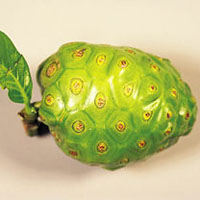Noni
Uses
Parts Used & Where Grown
Native to Polynesia, the noni plant (also known as Indian mulberry) is a small tree that usually grows to a height of ten feet. The fruit, which starts out green and turns yellow, is used medicinally.
Our proprietary “Star-Rating” system was developed to help you easily understand the amount of scientific support behind each supplement in relation to a specific health condition. While there is no way to predict whether a vitamin, mineral, or herb will successfully treat or prevent associated health conditions, our unique ratings tell you how well these supplements are understood by the medical community, and whether studies have found them to be effective for other people.
For over a decade, our team has combed through thousands of research articles published in reputable journals. To help you make educated decisions, and to better understand controversial or confusing supplements, our medical experts have digested the science into these three easy-to-follow ratings. We hope this provides you with a helpful resource to make informed decisions towards your health and well-being.
3 StarsReliable and relatively consistent scientific data showing a substantial health benefit.
2 StarsContradictory, insufficient, or preliminary studies suggesting a health benefit or minimal health benefit.
1 StarFor an herb, supported by traditional use but minimal or no scientific evidence. For a supplement, little scientific support.
This supplement has been used in connection with the following health conditions:
| Used for | Why |
|---|---|
1 Star Immune Function Refer to label instructions | Studies show noni to have some immune-enhancing activity. Animal and test tube studies show to have some immune-enhancing activity. Specifically, the polysaccharide component has been shown to increase the release of immune-enhancing compounds that activate white blood cells to destroy tumor cells. The usual recommendation is 4 ounces of noni juice 30 minutes before breakfast (effectiveness is thought to be best on an empty stomach). Human studies are needed to confirm the usefulness of noni. |
Traditional Use (May Not Be Supported by Scientific Studies)
Traditional Polynesian healers have used the fruit of the noni plant for just about everything—from a tonic drink to mending broken bones—but it is said that because of its strong, unpleasant odor and bitter taste, a person won’t take it until they are too sick and desperate. The bark yields a red dye while the root yields a yellow one. Both colors were used in the ceremonial outfits of Hawaiian chiefs. In the early 1990s, noni juice became heavily marketed in the United States primarily through network marketing companies. However, despite tremendous claims and testimonials, there is little scientific documentation on noni.
How It Works
The major constituents in noni appear to be polysaccharides and a compound known as damnacanthal.1, 2, 3 The developer of a commercial noni product claims the alkaloid xeronine is an important constituent, but there has been no confirmation by independent researchers. Animal and test tubes studies show noni to have immune-enhancing activity, and an earlier animal study seemed to indicate the fruit exerts a mild sedative effect.4, 5, 6 Specifically, the polysaccharide component has been shown to increase the release of immune-enhancing compounds that activate white blood cells. Also, damnacanthal is thought to be responsible for producing sedative effects in animal studies.
How to Use It
The usual recommendation is 4 ounces (120 ml) of noni juice 30 minutes before breakfast (effectiveness is thought to be best on an empty stomach). Commercial products are now available that have either eliminated the odor, altered the taste, or made it available as an extract in tablets or capsules to increase palatability. For liquid concentrates the typical recommendation is 2 tablespoons (30 ml) per day. For powdered extracts the typical recommendation is 500 to 1,000 mg daily.
Interactions with Supplements, Foods, & Other Compounds
Interactions with Medicines
Side Effects
There have been no commonly reported side effects following the ingestion of noni. Since the use of noni during pregnancy and breast-feeding has not been adequately studied, it is recommended that it not be used during these times.
1. Levand O, Larson HO. Some chemical constituents of Morinda citrifolia. Planta Med 1979;36:186-7.
2. Hirazumi A, Furusawa E. An immunomodulatory polysaccharide-rich substance from the fruit juice of Morinda citrifolia (noni) with antitumour activity. Phytother Res 1999;13:380-7.
3. Hiramatsu T, Imoto M, Koyano T, Umezawa K. Induction of normal phenotypes in ras-transformed cells by damnacanthal from Morinda citrifolia. Cancer Lett 1993;73:161-6.
4. Hirazumi A, Furusawa E, Chou SC, Hokama Y. Anticancer activity of Morinda citrifolia (noni) on intraperitoneally implanted Lewis lung carcinoma in syngeneic mice. Proc West Pharmacol Soc 1994;37:145-6.
5. Hirazumi A, Furusawa E, Chou SC, Hokama Y. Immunomodulation contributes to the anticancer activity of morinda citrifolia (noni) fruit juice. Proc West Pharmacol Soc 1996;39:7-9 .
6. Younos C, Rolland A, Fleurentin J, et al. Analgesic and behavioural effects of Morinda citrifolia. Planta Med 1990;56:430-4.
Last Review: 05-24-2015

Copyright © 2024 TraceGains, Inc. All rights reserved.
Learn more about TraceGains, the company.
The information presented by TraceGains is for informational purposes only. It is based on scientific studies (human, animal, or in vitro), clinical experience, or traditional usage as cited in each article. The results reported may not necessarily occur in all individuals. For many of the conditions discussed, treatment with prescription or over the counter medication is also available. Consult your doctor, practitioner, and/or pharmacist for any health problem and before using any supplements or before making any changes in prescribed medications. Information expires December 2024.
This information does not replace the advice of a doctor. Ignite Healthwise, LLC, disclaims any warranty or liability for your use of this information. Your use of this information means that you agree to the Terms of Use. Learn how we develop our content.

